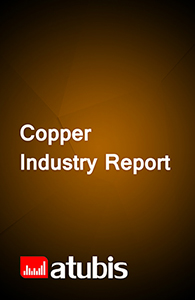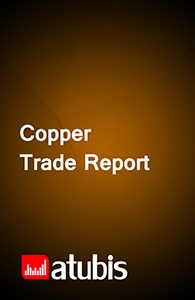Turkey’s Refined Copper Market Outlook Report
9,634€
- TRY: 475,000 ₺
Blister, anode, and refined copper (including ER and EW cathode) are the most important upstream copper products following mine production. Blister and anode are produced in smelting furnaces; in some technologies, anode is directly produced from concentrate without being converted into blister. Refined copper is produced in copper refineries. In electrorefining, anode is converted into cathode, whereas in electrowinning, water solution with copper content is precipitated and cathode is produced.
Product Description
With a GDP of $761 billion in 2019, Turkey was the second largest economy in the region that year, behind Saudi Arabia. The country joined the Economic Cooperation Organization in 1961 and also became a member of G20 in 1991. However, Turkey is still a developing country, according to the UN in 2019. Large parts of the country are located on the West Asia copper belt. The country has the second largest copper reserves in the Middle East, behind Iran, but it is not ranked highly on a global scale. As a result, the country’s copper industry is mostly focused on downstream sectors; developments in the downstream sectors down to wires and cables have turned the country into one of the largest exporters of copper products in the region.
Market drivers of Turkey’s refined copper
Capacities in Turkey’s downstream copper are so great that cathode demand is beyond domestic output capabilities; more than 75% of total demand is met through imports. The wide gap between domestic output and imports can drive refined production.
Currently, due to its high prices, copper has been replaced with other metals such as aluminum and zamak in some applications. With forecasts of higher copper prices in the future, the trend is expected to continue. This can put pressure on demand growth for copper and refined copper by extension.
Turkey reported the first case of Covid-19 in the latter half of March 2020. Not much longer, in mid-April, daily confirmed cases exceeded 5,000 and the country was officially facing a pandemic. To fight the pandemic, the government restricted businesses and ordered nation-wide lockdowns. As a result, the country’s mobility index dropped to around 60%. Thus, Turkey’s real GDP growth is forecast to be around -1%. With the restrictions implemented by the government due to the Covid-19 pandemic, demand for most copper products, and refined copper as a result, will weaken.
Overview of Turkey’s refined copper market
Imports account for a major share of Turkey’s refined demand. Limited availability of raw materials and the high costs of energy have restricted the profit margins of producers, impeding developments in the upstream sectors. Currently, CIS member countries are the main import source for Turkey’s refined copper, followed by Chile, the world’s largest mine producer, and Iran. Due to the economic contraction and declining industrial activity, imports of refined copper into Turkey have decreased over the recent years. Nonetheless, industrial activities are expected to recover over the coming years and put the economy back on the path of growth. Thus, demand for refined copper is expected to improve, but due to forecasts of higher copper prices and the relative increase of scrap supply, a major portion of the country’s future copper demand is expected to be supplied with scrap. On this basis, net imports are expected to remain relatively flat over the coming years.
Breakdown of Turkey’s refined copper market
Turkey’s cathode output is analyzed in terms of raw materials, production processes, and applications. In the first breakdown, refined copper falls into primary and secondary cathode based on raw materials. The supply of refined copper is categorized as ER and EW cathode. Demand for cathode is broken down based on applications in different consumer industries including producers of unwrought copper, wire rod, tubes, and casting parts; wire rod producers are the largest consumers of refined copper.
Key players in Turkey’s refined copper market
- Eti Bakır A.Ş.
- Central Asia Metals Plc
Additional Information
| Industry | Refined Copper |
|---|---|
| Region | Turkey |
| Report Type | Industry Report |
Specifications
| Report Attribute | Details |
| The base year for estimation | 2019 |
| Historical data | 2009-2018 |
| Forecast period | 2020-2025 |
| Quantitative units | Value in USD and Volume in Tonne |
| Report coverage | Market Overview, Dynamics, Market Outlook, Risks to Forecast, Consumer Market, Industry Overview, Market Landscape, Competitive Landscape, Market Attractiveness, External Macro Environment Analysis |
| Segments covered | Composition, Type, Application |
| Pricing and purchase options | Please explore our purchase options to meet your exact research needs. |
Reasons to Buy
- Recognize the geographical distribution of import demand
- Identify the current and future key players of the trading market
- Achieve a better insight on potential target markets
- Understand the behavior of major suppliers/customers either globally or regionally
- Identify competitors as a feed for market analysis
Table of Content
- Executive summary
- Introduction
- Objective
- Market under study
- Product
- Product specifications
- Consumption structure
- Applications
- Physical properties
- Subjects discussed
- Geographical scope under study
- Study timeframe
- Study currency
- Potential audience
- Market dynamics
- Market drivers
- Restraints
- Opportunities
- Challenges
- Market overview
- Market size
- Industry capacities
- Existing capacities
- Capacity distribution
- Geographical distribution of capacities
- Future capacities
- Existing capacities
- Output
- Output trends
- Operating rates
- Consumption
- Consumption trend
- Consumption Share of domestic product
- Trade
- Exports
- Imports
- Trade balance
- Market balance
- Market breakdown by product type
- Market breakdown by product type
- Market breakdown by application
- Inventory
- Producers inventory
- Consumers inventory
- Traders inventory
- Market outlook
- Market factors
- Raw materials
- Costs and prices
- Competition
- The government
- Other factors
- Future scenarios
- Risks to forecast
- Market factors
- Consumer markets
- End-user markets
- Building construction
- Infrastructure construction
- Transportation manufacturing
- Industrial equipment manufacturing
- Durable goods manufacturing
- Consumable goods manufacturing
- Direct consumer markets
- Major Direct consumers
- Existing capacities
- Drivers
- Major Direct consumers
- End-user markets
- Export potentials
- Destinations
- Trade and insurance costs
- Import market suppliers
- Producers potential share
- Destinations
- Industry overview
- Raw materials
- The supply volume of raw materials
- Supply channels of raw materials
- Raw materials procurement costs
- Cost structure of producers
- Production cost curve
- Industry value added
- Generated new scrap
- Technology
- Raw materials
- Market landscape
- Domestic sales markets
- Pricing in the domestic market
- Potential domestic demand
- Trade agreements for imports
- Foreign suppliers
- Foreign sales market
- Prices
- Potential markets overview
- Trade agreements for exports
- Foreign customers
- Domestic sales markets
- Competitive landscape
- Producers
- Company profile
- Revenue structure
- Gross profit margins
- Capacity, output and sales
- Consumers
- Company profile
- Revenue structure
- Gross profit margins
- Capacity, output and sales
- Producers
- Market attractiveness
- Industry rivalry
- Threat of new entrants
- Threat of substitutes
- Bargaining power of buyers
- Bargaining power of suppliers
- Conclusion of Porter analysis
- PESTEL analysis
- Political factors
- Economic factors
- Social factors
- Technology factors
- Environmental factors
- Legal factors
- SWOT analysis
- Large-scale companies with favorable conditions
- Short-term strategies
- Long-term strategies
- Large-scale companies with unfavorable conditions
- Short-term strategies
- Long-term strategies
- Small enterprises with favorable conditions
- Short-term strategies
- Long-term strategies
- Small enterprises with unfavorable conditions
- Short-term strategies
- Long-term strategies
- Large-scale companies with favorable conditions
List of Figures
- Output and consumption; 2010-2019
- Market share of product applications; 2019
- Market surplus; 2019-2025
- Production process flowchart
- Market size; 2010-2025
- Existing capacity; 2010-2019
- Capacity distribution; 2019
- Geographic distribution of capacities; 2019
- Development of future capacity; 2010-2025
- Amount of output; 2010-2025
- Operating rates of production plants; 2010-2025
- Amount of consumption; 2010-2025
- Consumption share of domestic product; 2010-2025
- Exports of product; 2010-2019
- Imports of product; 2010-2019
- Historical trade balance; 2010-2019
- Future Market balance; 2021-2025
- Market output breakdown by alloy type; 2010-2025
- Market consumption breakdown by alloy type; 2010-2025
- Market balance breakdown by alloy type; 2010-2025
- Market output breakdown by product type; 2010-2025
- Market consumption breakdown by product type; 2010-2025
- Market balance breakdown by product type; 2010-2025
- Market consumption breakdown by application; 2010-2025
- Inventories of raw materials and products at producers factories; 2010-2019
- Consumers’ inventory of product; 2010-2019
- Traders’ inventory; 2010-2019
- Production forecast, according to raw materials and sales analysis; 2019-2025
- Market surplus; 2019-2025
- The share of end-user industries in the consumption; 2010 and 2019
- Changes in the end-consumption of extrusion products; 2019 vs 2025
- Applications in building construction industry; 2019
- Applications in infrastructure construction industry; 2019
- Applications in transportation manufacturing industry; 2019
- Applications in industrial equipment manufacturing industry; 2019
- Applications in durable goods manufacturing industry; 2019
- Applications in consumable goods manufacturing industry; 2019
- Capacity distribution structure of direct consumers; 2019
- Existing capacities of direct consumers in each province; 2019
- Suppliers of the export potential destination; 2019
- Historical exports to the export potential destination and future potential; 2016-2025
- Up-stream domestic supply; 2010-2019
- Raw materials domestic supply; 2010-2019
- Supply channels of producer plants
- Spot price of raw material in the market; 2010-2025
- Cash cost structure for production the product; 2019
- Production cost curve of the plants; 2019
- Gross value added of the industry; 2010-2019
- Generated new scrap; 2010-2019
- Sales channels
- Realized price of the product in the market; 2010-2025
- Potential demand of each province; 2019
- The main foreign suppliers to the market; 2010-2019
- FOB price vs domestic market; 2010-2025
- Map of global major importers > 20,000t; 2019
- Major foreign customers; 2010-2019
- Revenue structure of the producers; FY2019
- Sales income and gross profit margin of the producers; FY2010-2019
- Output and sales of the producers; FY2010-2019
- Revenue structure of the consumers; FY2019
- Sales income and gross profit margin of the consumers; FY2010-2019
- Output and sales of the consumers; FY2010-2019
- SWOT matrix for large-scale companies with favorable conditions
- Strategies positioning for large-scale companies with favorable conditions
- SWOT matrix for large-scale companies with unfavorable conditions
- Strategies positioning for large-scale companies with unfavorable conditions
- SWOT matrix for small enterprises with favorable conditions
- Strategies positioning for small enterprises with favorable conditions
- SWOT matrix for small enterprises with unfavorable conditions
- Strategies positioning for small enterprises with unfavorable conditions



